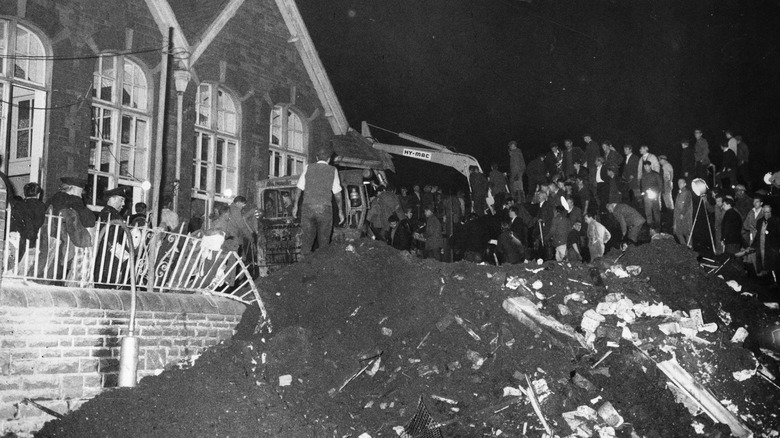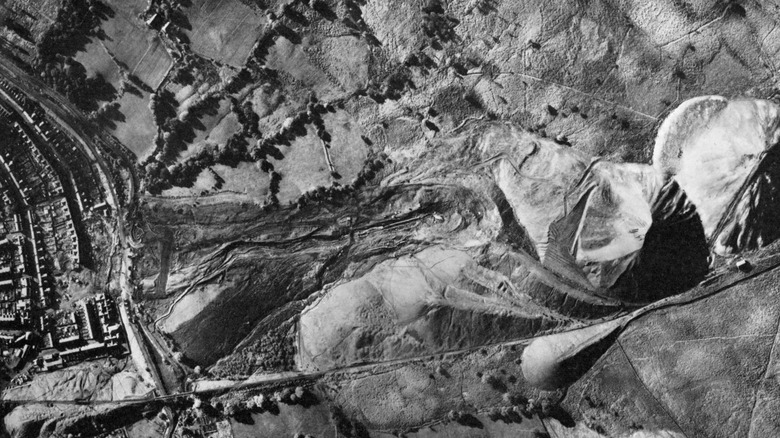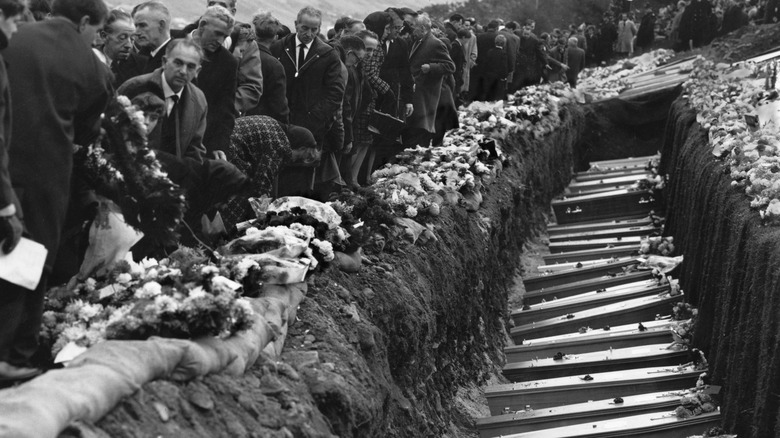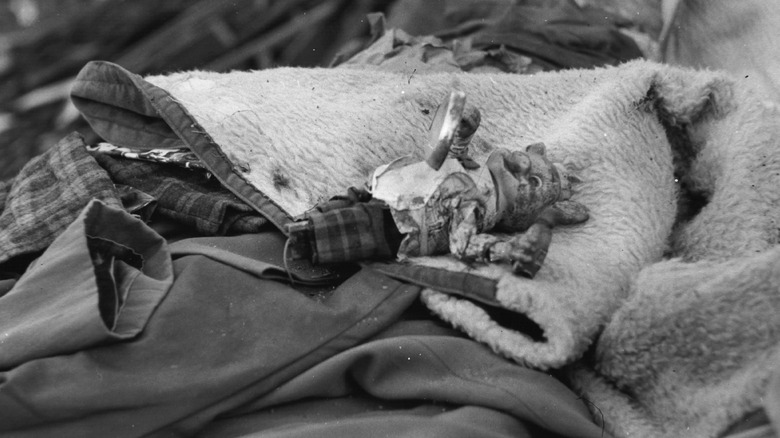What Really Happened When An Avalanche Of Coal Waste Hit Aberfan
Known as the worst mining-related disaster in Great Britain, the 1966 Aberfan disaster devastated a community in Wales. Initially, Queen Elizabeth didn't visit Aberfan after the tragedy and decided to send Prince Phillip instead, per Elle. While she did end up visiting the village almost a week after the disaster, Queen Elizabeth would later say in 2002 that her delayed response was her biggest regret of her reign (per The Free Library).
At the end of the day, the people of Aberfan received little justice for the tragedy. Ultimately, the blame lay entirely with the National Coal Board and their criminal negligence for failing to remove a collapsed spoil tip — a pile of coal waste, a byproduct of the mining process. But the subsequent inquiry didn't result in a single demotion, dismissal, or prosecution. The National Coal Board didn't face a single corporate sanction and there were no prosecutions, Wales Online reports.
While the National Coal Board did everything it could to avoid any and all responsibility, it became clear that there had been numerous warnings regarding the spoil tip.
An avalanche of nightmares
Around 7:30 a.m. on October 21, 1966, workers at the Aberfan Colliery in Aberfan, Wales noticed that one of the colliery spoil tips had started to slide. According to Smithsonian Magazine, the spoil tip contained almost 300,000 cubic yards of waste and towered 111 feet above the ground. Although the workers decided not to work that day to prevent further slippage, there was little they could do when two hours later a "glistening black avalanche" began rushing down.
Hurtling down the hillside at a speed of more than 80 mph, the "tsunami of sludge" was up to 30 feet tall. According to the British Geological Survey, the coal waste avalanche burst through the Pantglas Junior School, 18 houses, and part of the neighboring County Secondary School, before settling on Aberfan Road at 9:15 a.m.
There were 240 children at Pantglas Junior that day, and it was the last day before the school took a half-term break. The BBC reports that Gaynor Madgwick remembers waiting for the math lesson to begin when suddenly a "horrific noise" started getting louder and louder. All of a sudden they saw the black avalanche coming towards the windows and within seconds they were "catapulted to the back of the classroom — I just remember looking around desks, chairs, mud, slurry." Those who survived ended up trapped inside the school "in a flood of thick, quicksand-like sludge."
A week of recovering bodies
By the time the evening edition of the South Wales Argus came out that day, numerous bodies had already been found in the rubble of Pantglas Junior School. South Wales Argus writes that while South Wales "was used to seeing the horrors of pit disasters, it had seen nothing like this." Up to 400 miners came from the colliery to try to dig children out of the black slurry.
The police spokesperson claimed by the evening that it was "impossible" to think about there being survivors. According to the British Geological Survey, the last child found alive was Jeff Edwards, who was brought out of the rubble at 11 a.m. While over 100 children ended up surviving and being rescued in the immediate aftermath, 116 children, mostly aged 7 to 10, and 28 adults, five of whom were teachers, died as a result of the avalanche, per BBC.
After the coal waste avalanche had crashed through the Pantglas Junior and settled, silence hung in the air. Cyril Vaughan, a teacher at the senior school, said that it was as though "nature had realized that a tremendous mistake had been made and nature was speechless," per Smithsonian Magazine. The subsequent Tribunal would also find that the National Coal Board had repeatedly ignored warnings that the spoil pit would be a danger to the school in the event of heavy rain, per ITV.
What happened to the people of Aberfan?
The Tribunal of Inquiry into the Aberfan Disaster was created on October 26, 1966 to investigate the disaster. According to The U.K.'s National Archives, the Tribunal concluded on April 28, 1967 that while the National Coal Board was clearly responsible for the tragedy, "the Aberfan Disaster is a terrifying tale of bungling ineptitude by many men charged with tasks for which they were totally unfitted, of failure to heed clear warnings, and of total lack of direction from above. Not villains but decent men, led astray by foolishness or by ignorance or by both in combination, are responsible for what happened at Aberfan." ITV reports that the Tribunal also found that if proper site investigations had been carried out, the tragedy would have been completely avoidable.
For those who survived, life was never the same. Edwards, the last surviving child to be rescued, said that while the physical injuries healed, the psychological trauma he experienced that day would "never really be dealt with," per BBC. According to The Guardian, at least half of the survivors of the Aberfan disaster ended up experiencing PTSD at some point in their life.
The Aberfan Disaster Fund raised over $2.3 million, but The Geological Society writes that over $200,000 ended up being used to clear the remaining spoil tips around the village, a task which the National Coal Board refused to do.



